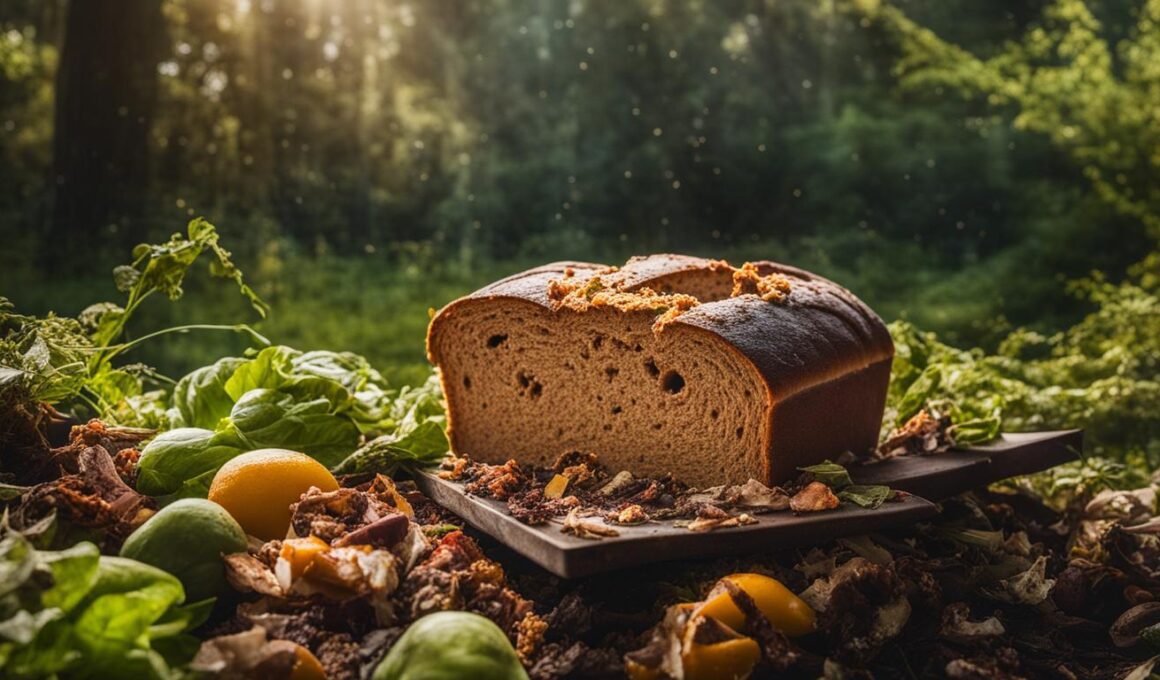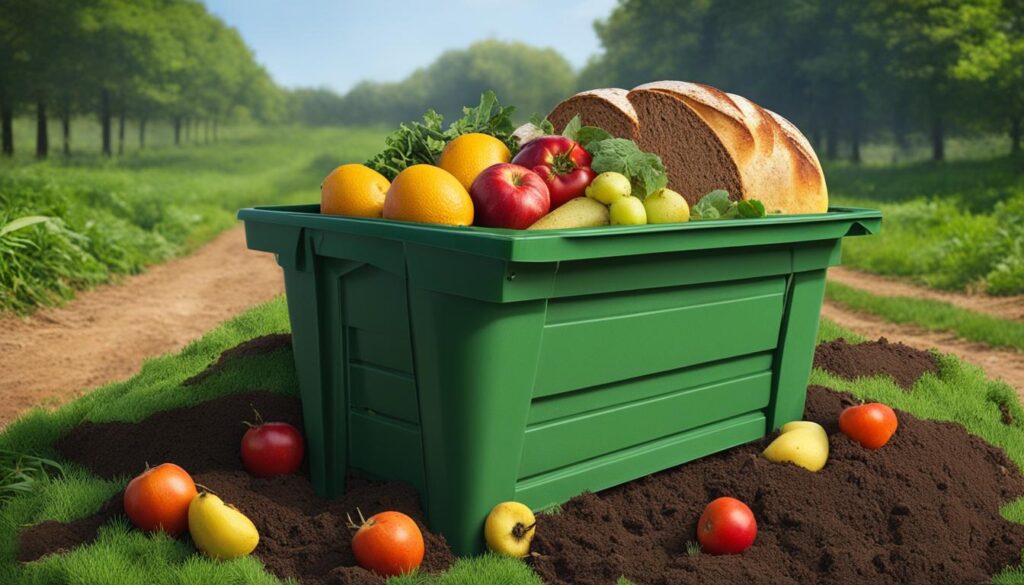Are you wondering if you can compost bread? The answer is yes, you can! Composting bread is a great way to reduce waste and create nutrient-rich compost for your garden. However, there are a few things to consider when composting bread.
Bread can be considered a “green” compost material due to its high nitrogen content, which makes it a valuable addition to your compost pile. It helps reduce methane emissions in landfills, as bread decomposes slowly and emits harmful greenhouse gases when thrown away.
Composting bread is relatively simple, but there are a few factors to keep in mind. Balancing it with “brown” materials like straw or leaves is important to maintain the right carbon-to-nitrogen ratio in your compost pile. Additionally, moldy bread can also be composted and tends to decompose faster.
Post Summary
- Composting bread helps reduce methane emissions and diverts waste from landfills.
- Balance bread with “brown” materials like straw or leaves in your compost pile.
- Moldy bread can be composted and decomposes faster.
- Consider using a composting system like Subpod for an efficient and odor-free composting experience.
- Composting bread contributes to a more sustainable and eco-friendly lifestyle.
Why Should We Compost Bread?
Composting bread offers several benefits that contribute to sustainability and environmental conservation. By composting bread instead of sending it to a landfill, you can help reduce methane emissions, which are a significant contributor to climate change. Methane is a potent greenhouse gas that has a much greater warming effect than carbon dioxide. When bread decomposes in a landfill, it releases methane into the atmosphere. However, by composting bread, you divert it from the landfill and create nutrient-rich compost instead.
| Benefits of Composting Bread |
|---|
| 1. Reduces methane emissions |
| 2. Diverts waste from landfills |
| 3. Creates nutrient-rich compost for gardening |
Composting bread also helps in reducing the overall waste that goes into landfills. By composting bread, you actively participate in the circular economy by turning food waste into a valuable resource. The compost created from bread can be used as organic fertilizer, providing essential nutrients to your plants and promoting healthy growth. It reduces the need for synthetic fertilizers, which can have negative environmental impacts.
Furthermore, composting bread aligns with sustainable living practices, as it reduces reliance on traditional waste disposal methods. It allows you to take an active role in managing your own waste and engaging in environmentally friendly practices. By composting bread, you contribute to the conservation of natural resources, minimize pollution, and work towards a greener future.
How to Compost Bread
Composting bread is a straightforward process that requires a few considerations to ensure optimal decomposition and avoid common problems. Follow these tips and techniques to successfully compost bread:
1. Choose the right compost system:
Select an enclosed compost bin or an underground composting setup to discourage pests and rodents from accessing the bread. These systems provide a controlled environment for composting and help maintain the ideal composting conditions.
2. Break the bread into smaller pieces:
Increasing the surface area of the bread by breaking it into smaller pieces promotes faster decomposition. Consider tearing or cutting the bread into smaller chunks before adding it to your compost pile.
3. Proper placement in the compost pile:
Place the bread in the center of your compost pile or bin, burying it to prevent easy access for pests. This helps prevent unwanted visitors and ensures that the bread decomposes evenly along with other compostable materials.
4. Balance with brown materials:
When composting bread, it’s important to balance it with “brown” materials that are carbon-rich, such as straw, leaves, or sawdust. Aim for a ratio of two to three parts brown materials to one part green materials (like bread) for optimal decomposition.
By following these bread composting techniques, you can effectively compost bread and contribute to reducing waste while creating nutrient-rich compost for your garden.
| BENEFITS | COMPOSTING BREAD TIPS |
|---|---|
| Reduces methane emissions | Choose an enclosed compost system to discourage pests |
| Creates nutrient-rich compost | Break bread into smaller pieces to increase surface area |
| Reduces waste in landfills | Properly place bread in the center of the compost pile |
Composting bread not only helps reduce methane emissions from landfills but also creates valuable compost for your garden, promoting healthy plant growth.
Remember to regularly mix and aerate your compost pile, maintain the right balance of greens and browns, and monitor moisture levels to ensure successful bread composting.
In summary, when it comes to composting bread, opt for stale or mouldy bread without added non-compostable items. Breaking the bread into smaller pieces and mixing it with other compostable materials will aid in faster decomposition. By making mindful choices in the bread you compost, you can contribute to a more sustainable and eco-friendly lifestyle.
How to Avoid Common Problems When Composting Bread
Composting bread can be a rewarding and eco-friendly practice, but it’s important to be aware of potential issues that may arise. By following these tips, you can prevent common problems and ensure successful bread composting.
Tip 1: Use an Enclosed Compost Bin
One of the challenges in composting bread is attracting pests such as rodents. To avoid this, consider using an enclosed compost bin or underground composting system. These designs help minimize accessibility for pests and keep your composting area tidy and protected.
Tip 2: Maintain a Balanced Carbon-to-Nitrogen Ratio
Bread is considered a “green” compost material due to its high nitrogen content. However, too much bread in your compost pile can make it too wet. To maintain the ideal moisture level, balance the bread with “brown” materials like leaves or sawdust. Aim for a ratio of two to three parts brown to one part green materials for optimal composting.
Tip 3: Regularly Turn and Aerate Your Compost
Proper aeration is crucial for composting success. Turning your compost pile regularly helps distribute oxygen and accelerate decomposition. Use a pitchfork or compost aerator to mix the materials thoroughly. This will prevent the bread from clumping together and promote even breakdown throughout the compost pile.
Remember to monitor the moisture levels in your compost pile as well. If it becomes too wet, add dry carbon-rich materials like shredded paper or straw. If it’s too dry, sprinkle water to increase moisture content.
By following these tips, you can overcome common challenges and troubleshoot any issues that may arise during the composting process. Composting bread not only diverts waste from the landfill but also creates nutrient-rich compost for your garden, promoting a more sustainable and environmentally friendly lifestyle.
| Common Problems | Solutions |
|---|---|
| Attracting pests | Use an enclosed compost bin or underground composting system to deter pests. Make sure the bin is properly sealed. |
| Imbalanced moisture | Add “brown” materials like leaves or sawdust to balance the high nitrogen content of bread. Regularly monitor the moisture level and adjust accordingly. |
| Poor aeration | Regularly turn and mix the compost pile to promote proper aeration. Use a pitchfork or compost aerator to ensure even breakdown of materials. |
Eco-Friendly Ways to Use Leftover Bread
Reducing food waste is an important step towards a more sustainable kitchen. Instead of composting leftover bread, you can repurpose it in creative ways to maximize its value and minimize waste. Here are some eco-friendly ideas:
- Breadcrumbs: Turn stale bread into breadcrumbs by pulsing it in a food processor. Use them as a coating for fried foods or as a topping for casseroles.
- Croutons: Cut stale bread into cubes, toss them with olive oil and herbs, then bake until crispy. Sprinkle these homemade croutons on salads or soups.
- Bread Pudding: Combine stale bread with milk, eggs, sugar, and your choice of flavors like cinnamon or vanilla. Bake this comforting dessert for a delicious treat.
- Freeze for later: If you can’t use the bread right away, freeze it in a sealed bag. Defrost individual slices when needed for toast or sandwiches.
By repurposing stale bread, you not only reduce food waste but also get to enjoy tasty homemade treats. Get creative in the kitchen and embrace sustainable practices to contribute to a greener lifestyle.
Avoiding Food Waste Tips:
“Plan your meals and shopping wisely to avoid buying more bread than you need. Store bread properly in a cool, dry place or in the freezer to prolong its freshness. When using bread for sandwiches, consider using the end pieces or crusts to minimize waste. And remember, if you have stale or moldy bread, don’t throw it away; repurpose it or compost it.”
Optimal Composting System: Subpod
If you’re looking for an efficient and convenient composting system, Subpod is the perfect solution. Subpod is an underground vermicomposting system that offers several advantages for composting bread and other food waste. With its innovative design and features, Subpod makes home composting a simple and rewarding experience.
One of the key benefits of using Subpod is its underground installation. By sitting below the surface of your garden, Subpod blends seamlessly into your outdoor space. Its discreet design not only saves valuable garden real estate but also minimizes odors commonly associated with traditional composting setups. With Subpod, you can compost bread without worrying about unpleasant smells disturbing your outdoor environment.
Another advantage of the Subpod composting system is its reliance on worms and aerobic activity. The worms inside Subpod efficiently break down bread and other food waste, turning them into nutrient-rich compost. This process creates organic fertilizer that nourishes your plants and promotes healthy growth. By composting bread with Subpod, you not only reduce waste but also contribute to a greener and more sustainable garden.
Using Subpod is also incredibly convenient. Its easy-to-use and low-maintenance design make composting a hassle-free task. You can simply add your bread scraps and other food waste to the Subpod, and the worms will do the rest of the work. With regular feeding and monitoring, you’ll have a constant supply of nutrient-rich compost to enrich your garden soil.
Advantages of Subpod:
- Underground installation minimizes odors and blends into the outdoor environment.
- Reliance on worms and aerobic activity for efficient decomposition.
- Creates nutrient-rich compost for healthier plant growth.
- Easy-to-use and low-maintenance design.
In summary, Subpod is the optimal composting system for composting bread and other food waste. Its underground vermicomposting setup, reliance on worms and aerobic activity, and convenient design make composting a breeze. By using Subpod, you can contribute to a more sustainable lifestyle while enjoying the benefits of nutrient-rich compost for your garden.
Benefits of Composting Bread with Subpod
Composting bread with Subpod offers numerous benefits that make it an excellent choice for your composting needs. One of the key advantages is the production of nutrient-rich compost. As bread and other food waste decompose inside the Subpod, worms and beneficial microorganisms break them down, creating a compost that is rich in essential nutrients. This compost can then be used to nourish your garden, promoting healthy plant growth and reducing the need for synthetic fertilizers.
Another benefit of using Subpod for composting bread is its neighbor-friendly design. Traditional composting systems can sometimes emit unpleasant odors, attracting pests and causing concerns for nearby neighbors. However, Subpod’s enclosed design minimizes odors and prevents pests from accessing the compost, ensuring a pleasant composting experience for both you and your neighbors.
In addition to these benefits, Subpod simplifies the composting process by creating a self-contained environment. This means that you don’t need to worry about constructing or maintaining a separate compost pile. The composting takes place directly within the Subpod, making it a convenient and hassle-free solution for composting bread and other organic waste.
Comparing Composting Systems
| Traditional Composting | Subpod | |
|---|---|---|
| Odor | May emit odor | Minimal to no odor |
| Pests | Attracts pests | Pest-proof design |
| Nutrient-rich compost | Yes | Yes |
| Convenience | Requires separate compost pile | All-in-one system |
Comparing traditional composting methods with Subpod highlights the clear benefits of using Subpod for composting bread. Subpod offers minimal odor and pest issues, ensuring a neighbor-friendly composting experience. It also produces nutrient-rich compost that can enhance your garden’s health. Additionally, Subpod’s convenient all-in-one design simplifies the composting process, making it a superior choice for composting bread and other food waste.
By choosing Subpod as your composting system, you not only contribute to reducing food waste but also play a part in creating a more sustainable and eco-friendly lifestyle. Composting bread with Subpod offers a simple and efficient way to turn food waste into valuable compost, benefiting both your garden and the environment.
Conclusion
Composting bread is a practical and eco-friendly way to reduce waste and contribute to a sustainable lifestyle. By composting bread, you can help reduce methane emissions from landfills and create nutrient-rich compost for your garden. It is important to balance bread with “brown” materials like straw or leaves to maintain the right moisture balance in your compost pile and prevent attracting pests.
Using the Subpod composting system can greatly enhance your bread composting experience. With its underground vermicomposting design, Subpod efficiently breaks down bread and other food waste, while minimizing odors and pests. The resulting compost is a valuable resource for nourishing your garden and promoting healthy plant growth. By embracing composting and utilizing systems like Subpod, you can play a part in creating a greener and more sustainable environment.
In summary, composting bread is a simple yet impactful practice that contributes to waste reduction, greenhouse gas mitigation, and the creation of nutrient-rich compost. By following the recommended techniques and considering the use of the Subpod composting system, you can successfully compost bread and actively participate in a more sustainable and environmentally-conscious way of life.
Is Composting Pasta Similar to Composting Bread?
Composting pasta in the garden is similar to composting bread, as both are organic materials that can enrich the soil. However, pasta may break down more slowly due to its denser texture. When composting pasta in the garden, it’s important to monitor the moisture levels to ensure proper decomposition.
FAQ
Can you compost bread?
Yes, bread can be composted, but it depends on certain factors.
Why should we compost bread?
Composting bread is beneficial because it helps reduce methane emissions in landfills and creates nutrient-rich compost for your garden.
How to compost bread?
Start by choosing the right compost system, break the bread into smaller pieces, and balance it with “brown” materials like straw or leaves.
Can you compost mouldy bread?
Yes, mouldy bread can be composted and tends to decompose faster. Vermicomposting systems like Subpod can easily digest mouldy bread.
What are the problems with composting bread?
Common issues include attracting pests and maintaining the right moisture balance in the compost pile.
Which bread is best for composting?
Stale or mouldy bread is best for composting, but plain bread without added dairy or non-compostable ingredients is also suitable.
How to avoid common problems when composting bread?
Use an enclosed compost bin or bury the bread deep in the compost pile, mix it with other compostable materials, and monitor moisture levels.
What are eco-friendly ways to use leftover bread?
Stale bread can be repurposed into breadcrumbs, croutons, or bread pudding, or frozen for later use as toast or sandwiches.
What is the optimal composting system for composting bread?
Subpod is an in-ground vermicomposting system that efficiently composts bread and other food waste, minimizing odors and pests.
What are the benefits of composting bread with Subpod?
Composting bread with Subpod creates nutrient-rich compost and offers an odor-free and pest-free composting experience.
What are the final thoughts on composting bread?
Composting bread is a feasible and environmentally-friendly practice that contributes to a more sustainable lifestyle.











